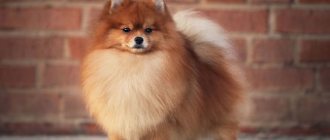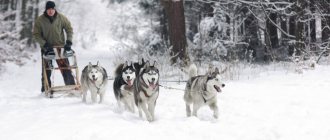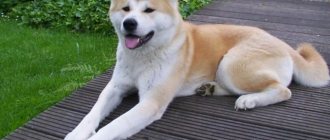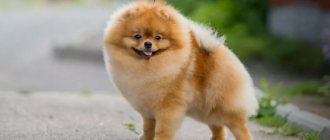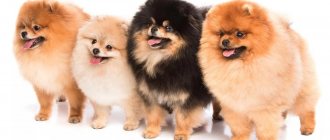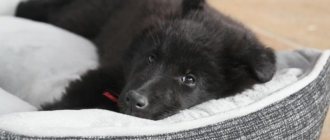Photo by Rem RASSAT on Unsplash
The Spitz Samoyed is a northern sled dog, a distant relative of the Pomeranian. Despite the external differences, the animals are part of a common group and have similar exterior parameters.
Let's look at the history of the Samoyed breed, analyzing its features, and also tell you about the basic rules for care and maintenance.
Origin story
The Samoyed Spitz breed was officially recognized in 1959.
This sled dog got its name from a small ethnic group living in northern Russia. Initially, he got her as a companion, because the Samoyed groups of peoples did not use dogs as sled dogs because of their religions. The remaining tribes living on Novaya Zemlya, having acquired these dogs, began to use them specifically as transport for transporting goods. A snow-white dog harnessed to a sleigh blended into the snow, and it seemed as if they were riding on their own. Hence the name.
Samoyed Spitz
Externally, representatives of the breed resemble a polar wolf, so many researchers believe that the Samoyed Spitz originated from a domesticated wild fellow.
Nomads used these animals as shepherds for a herd of deer, and also as nannies for children. On chilly northern nights, the pet slept with its owner, warming him without disturbing his sleep. This fact is due to the presence of the instinct of freezing. If you hug an animal, it stops moving.
History of the breed
The Samoyed Spitz is one of the oldest breeds, descended from Siberian domesticated wolves.
Animals tamed by the northerners:
- were used as shepherds in reindeer pastures;
- helped with cargo transportation, acting as sled dogs;
- looked after the children;
- protected the owner from the cold, warming him with the warmth of their body;
- They were also used for hunting walruses and other northern animals.
The unusual name comes from the ancestors of the inhabitants living on the territory of the Nenets Autonomous Okrug and calling themselves “Samoyeds”.
Photo by Sveta Golovina on Unsplash
Painstaking work with aboriginal dogs began in the 89th year of the 19th century in Great Britain. Local breeders who founded the first club achieved recognition from international cynological organizations only 70 years later. The breed was included in the sled section.
Standards: description and photo
The Samoyed is a fairly confident dog. It is considered one of the most “talkative” breeds. Under a huge layer of soft and thick fur hides a medium-sized pet with excellent endurance and developed muscles. With all their power, they have the gentle character of a loving and faithful friend for their owner.
Breed standard
The following dogs are considered standardized:
- height varies from 53 to 56 cm;
- weight ranges from 17 to 30 kg;
- stocky in build, with developed bones;
- the back is medium in length, rather narrow, slightly higher towards the withers;
- long and straight paws, which are parallel and widely spaced from each other;
- the neck is slightly curved forward, of medium thickness;
- wide, slightly rounded forehead;
- black nose, straight, well-developed nostrils;
- a muzzle of strong build with a length proportional to the width of the skull, slightly narrowing towards the nose;
- the bite resembles a scissors, the teeth are well developed;
- fleshy lips slightly full, corners raised upward, black;
- the ears are small, resembling standing triangles with rounded tips;
- the eyes are shaped like almonds, widely spaced and deep-set, dark brown in color with a black edging;
- the fluffy tail is set high, during excitement it is bent towards the back and slightly to the side, and in a state of rest it is lowered down;
- The coat is double with short and soft down, as well as a thick and very long guard coat, which forms a spectacular collar around the neck. Shorter fur on the head and paws. Thick and long “pants”.
The color is snow-white, there may be a few areas of beige-cream shade. Brown Samoyeds, as well as pets with spots, are considered rejected.
Life expectancy varies from 10 to 15 years, depending on the dog’s lifestyle and diet.
Breed Features
Let's look at the exterior and temperament of a Spitz according to established breed standards, and also look at the existing basics of training.
Appearance: height, weight, color
The exterior approved by the FCI regulates the following parameters:
- Ears. Triangular and rounded at the tips. They are located at a great distance from each other and are in constant motion.
- Head. It has a wedge-shaped shape and a powerful skull equal to the length of the muzzle. Situated on a strong and slightly curved neck. There are 3 types of Samoyed head structure allowed: a. wolf, with a powerful skull and elongated muzzle; b. fox, accompanied by a light head with an elongated and pointed muzzle, as well as pointed and high-set ears; c. bearish, characterized by a rounded head and ears, as well as a shortened muzzle.
- Eyes. The shape is almond-shaped, the fit is deep and wide, the iris is represented by dark brown shades. Eye edging is considered mandatory.
- Nose. Straight, has a black lobe. Fading of the wool is acceptable, but it must have a dark edging.
- Jaws. Covered with fleshy black lips that curve upward and form a smile. They have a scissor bite.
- Body. The size is medium, the proportionality of the body is combined with flexibility and strength. The scapular joints are well defined.
- Limbs. Wide and parallel spaced. Long and muscular legs have a developed hock joint.
- Tail. The fit is high, the shape is crescent-shaped. The fluffiness is observed along the entire length, and the location changes depending on the state: in a calm state it goes down, in an excited state it rolls over on the back or on one of the sides.
- Height and weight parameters. Sexual dimorphism is pronounced. The maximum height and weight for Samoyed dogs reaches 56 cm and 25 kg, and for dogs - 60 cm and 30 kg.
- Wool. The undercoat is soft and short, and the guard hair is thick and long. The neck is decorated with a collar, and the hind legs are decorated with “pants”. In frosty weather, the hairs shimmer and fluff. Acceptable colors include: a. white; b. cream.
Please note that light sand or brown tones, as well as inclusions, are not allowed.
Character and behavior
Samoyeds love communication and take pride of place in the list of talkative dogs. Their character and psychological portrait include:
- Attachment. Samoyeds love every member of the family, regardless of their age.
- Friendliness. The pet will be happy to babysit the child and play with other animals. At the same time, he is completely unsuitable as a security guard, since he would never harm a stranger.
- Adequate perception of external stimuli. The Samoyed Spitz quickly finds a common language with blind people, acting as a guide and faithful friend.
- Playfulness. Even in old age, the Samoyed will not lose its former excitement, so it is an ideal partner for small children.
- Independence. The Samoyed Spitz senses a change in the owner’s mood and never imposes communication unless necessary. The downside here is the tendency to wander. The spirit of our ancestors often invites us to take a walk in freedom.
Character and behavior
The Samoyed Spitz is one of the most mischievous and cheerful dogs that are used for transporting goods. He loves active games. Good-natured character - he will allow himself to be petted even by a stranger.
Despite all the affection for the owner, it can periodically demonstrate independence, run away from home or while walking. May be stubborn during training.
The Samoyed remains playful until old age, so spend plenty of time walking and active games with your pet.
On a walk
Gets along easily with other animals living in the family, considering them members of his pack. Sensitive to changes in the owner's mood, can be used as a guide dog.
This is interesting! The Japanese Spitz is the most beautiful Spitz dog
These animals do not act as a guard; they do not show any aggression towards humans.
Maintenance and care
Photo by Alvan Nee on Unsplash
Properly care for your Samoyed and maintain the necessary conditions to maximize its lifespan. Compliance with all the rules will allow your pet to live up to 15 years or more.
Conditions of detention
All sled dogs require the largest possible territory to accommodate their activity and restlessness. Life in an urban environment is problematic for the Samoyed. He will probably destroy the whole house during the owner's absence, trying to distract himself from loneliness.
The thick coat allows them to withstand severe frosts. Street keeping is suitable for a Samoyed dog, but only on condition of free movement and not sitting on a chain. Otherwise, the Spitz risks developing mental disorders.
It deserves special attention that the free-willed nature of the Samoyed Spitz requires a strong enclosure and a high fence, excluding digging and jumping.
Feeding
Mixing 2 types of food is not allowed. The animal is fed high-quality dry food containing all useful microelements, or switched to natural feeding, including:
- meat, offal;
- cereals;
- vegetables and fruits;
- dairy products.
The growing body of puppies needs calcium and carbohydrates, so their diet contains more cereals and fermented milk products. Small Samoyeds are fed 4 times a day, gradually reducing the number of feedings to 2.
When choosing natural feeding, do not forget about vitamin and mineral complexes.
Features of care
Photo by Jp Valery on Unsplash
When caring for your Samoyed, follow these guidelines:
- Brush the coat with a metal comb as needed; the dog begins to shed twice a year, so the Samoyed's coat will have to be brushed daily.
- Take care of your teeth, ears and eyes. From time to time, clean out earwax and wipe your eyes if there is excessive tearing. For healthy teeth, use special toothpaste, chewing toys, or cleansing treats.
- Do not overuse bathing. 2 times a year is enough. The Samoyed Spitz is clean, and its coat does not accumulate dirt. After washing, it is important to dry your pet thoroughly. An under-dried undercoat may become dull and the skin may become irritated.
- Get enough time for physical activity. Try to take your Spitz outdoors and walk him for at least 1 hour every day.
Content
Despite the fact that Samoyeds can be kept well in an apartment, they need daily walking and sports games. It is better for such dogs to be kept in an enclosure or a private home. This will keep them on the move while playing in the open lawn or backyard.
It is better to keep dogs in an enclosure
Important ! Samoyeds cannot be kept on a chain.
Care and hygiene
Brush your Samoyed daily with a special brush with increased rigidity, and during shedding, remove the undercoat with a metal comb.
Bathe your pet no more than once every six months with a special detangling shampoo. After the procedure, be sure to dry the fur until completely dry using a hairdryer. If you wait until the fur dries naturally, fungal growths on the skin and eczema may form.
Due to their love for active walks, Samoyeds often damage their pads, so after walks, inspect your dog’s paws. If you find damage, treat with hydrogen peroxide or anoint with fucorcin.
These animals are immune to drafts and frosts due to their good coat. True, for those who live on the street, it is even warmer.
Attention ! If you plan to place a Samoyed in an enclosure, make it secure, because it can dig under the ground or jump over a high fence.
Nutrition and diet
The health, physical activity and quality of a Spitz's coat depend on the correct diet. The easiest way is to create a diet from specialized food of good quality.
Organizing a balanced natural diet will be more problematic, due to the fact that not all foods can be included in the Samoyed’s diet.
If you decide to feed your pet natural food, the diet must include:
- chicken, veal and offal;
- kefir and cottage cheese;
- cereals - buckwheat, rice, corn and rolled oats;
- any vegetables except potatoes and onions;
- fruits and berries.
The easiest way to feed a Samoyed is high-quality food.
Important ! Under no circumstances should you give your dog confectionery products, wheat pastries, pickles, smoked foods or processed foods.
If you decide to feed natural food, be sure to add vitamins to your pet’s diet. In any case, consult your veterinarian before adding supplements to your diet.
Diseases, breed defects
Since the dogs were not artificially bred, they have excellent immunity. However, be sure to vaccinate your puppy against various viral diseases before the age of one year:
- enteritis;
- plague;
- parainfluenza;
- hepatitis A;
- rabies - per year.
Puppies need to be vaccinated
Despite their excellent health, representatives of the breed are predisposed to the following pathologies:
- Eyes: retina and cataract. They can develop as a result of untreated conjunctivitis.
- Diabetes mellitus, hypothyroidism. These diseases of the endocrine system most often develop due to eating natural products.
- Kidney dysplasia. May be a congenital pathology.
- Articular dysplasia: occurs more often than in other northern dogs.
Character of the breed
There is little aggression in it, so the pet can let a stranger approach and let itself be petted. He loves to play and run around actively. Although the Spitz is friendly to its owner, it easily shows independence by running away during walks in the fresh air. This breed is suitable for a beginner, but you need to be patient when training.
The dog has high intelligence. She is easy to keep with other animals in the house, even cats. Don't be afraid to leave your dog with your children. If a child falls asleep with an animal, it will lie next to it, without moving, so as not to disturb it. The Arctic Spitz is a good companion for older people.
He is not afraid of noise and can be a guide for the blind. It is not recommended to use it to protect houses and people. The dog is non-aggressive and has no guard qualities. A busy person with a shortage of time should not get this animal, because attention is important for him. If this is not done, the animal begins to get sick and waste away.
This is a breed with an ideal character: kind, smart, quick-witted with a huge amount of energy. He loves to work in a team and communicate with people. But, despite all these features, the Arctic Spitz cannot be called soft-bodied. This is a dog with self-esteem, who can be stubborn and courageous. He will never get into a fight with another dog on the street.
Despite the fact that this type of dog was previously used as a hunting breed, the Spitz has practically lost these features. He can drive a cat up a tree, but he will not be eager for game when he is taken into the forest. He will be happy to give the children a sleigh ride. Contact is important to him. If you put your pet on a chain or do not communicate with him constantly, the dog can develop serious behavioral and mental disorders. Puppies often misbehave at an early age. It is important that the owner begins training in a timely manner.
Family life
The Samoyed is a great companion. Suitable for both older people and families with children. Dogs love children very much and can act as nannies.
You might like this! The American Eskimo Toy Spitz is an unrecognized beauty.
They are not fussy about their maintenance, and if you feed them dry food, there will be no health problems.
Unlike other representatives of Spitz-types, they will not be able to act as a domestic “bell” due to the fact that they are very friendly towards strangers.
Education and training
Representatives of the species are highly trainable, the main thing is to start training the puppy from an early age. You can independently teach how to perform standard commands: “Sit!”, “Come to me!”, “Ugh!”, “Lie down!”, “Nearby!”, “Walk!” To expand the list of commands, contact a dog handler. Start OKD courses no earlier than 3 months of your pet’s life.
A sled dog must go for a daily jog to keep its skeleton and muscles in good shape.
Riding
Advantages and disadvantages
Advantages of the breed:
- good health due to natural selection;
- cheerfulness;
- loyalty and devotion.
Flaws:
- expensive diet;
- possible joint problems;
- lack of security qualities.
Samoyeds are not the best option as guards. Both
the advantage and disadvantage of these dogs is their friendliness. On the one hand, this is very good, because the pet will not scare others on walks, but at the same time it shows its love for all strangers and does not notify the owner of the approach of strangers.
Nutrition
The playfulness, good mood and health of the Samoyed dog are associated with diet. The owner chooses what to feed the animal, but choosing a balanced menu of natural food for such a large breed is not easy. Meat and offal should not be fatty. It is also recommended to give your Spitz kefir and low-fat cottage cheese.
Rolled oats and buckwheat will be useful. Sometimes the diet is supplemented with rice and corn. The owner can give the dog any vegetables with the exception of potatoes and onions. Seasonal berries and fruits will help enrich your diet with vitamins. It is not recommended to give him confectionery, smoked meats, or canned pickles.
After one and a half months, the puppy is transferred from mother's milk to porridge. This dish is cooked with milk mixture. It is possible to add a small amount of fermented milk products to the menu. Feeding the puppy should occur every three to four hours.
Puppies aged three to four months are recommended to be given porridge cooked in broth and small pieces of lean meat. A dog should eat no more than four times a day. From four to six months of age, three meals a day are appropriate for a dog. Fruits, vegetables, and offal are added to the menu. After eight months, it is recommended to feed the puppy twice a day and add vitamin complexes to the menu when feeding it natural.
Buying a pet
What to look for when purchasing
When choosing a puppy, pay attention to the following:
- activity;
- sparkle in the eyes;
- wet nose;
- availability of vaccinations;
- pedigree;
- compliance;
- no lameness.
Puppy
Before you buy a Samoyed Spitz, determine for what purpose you want to do it:
- Companion - selected only by character and temperament, so that family members feel comfortable with him.
- Champion - show class pets are very expensive. When choosing a puppy, consult a specialist. Only an experienced expert will be able to predict with a high degree of accuracy the prospects of each litter.
- Sled dog - purchased for participation in sports competitions. At least one of the parents must be a working driver. You can wait a long time for such puppies, since there are quite a few northern Samoyeds.
Puppy price
The prices for these dogs are quite high. They range from 25,000 to 80,000 rubles, depending on the class. Pet class - from 25 thousand rubles, breed class - from 30 thousand rubles, and show class - from 50 thousand rubles.
The price of puppies varies depending on the class
Nurseries
Among the most famous and titled nurseries in Russia are:
- “Joy of Life” (Moscow);
- “Serenade of the Northern Valley” (St. Petersburg).
Purchasing a puppy
Before buying a puppy of this breed, you need to figure out what purpose the pet is needed in the house. Even within the same litter, all dogs are very different in character. Some are more meek, while others are endowed with leadership qualities. One dog may be more curious and active, while another prefers to sit in a corner or sleep. Regardless of character, according to the breed standard, the Samoyed should not be cowardly or malicious.
Before buying, you need to observe the animal you like. It is recommended to ask the breeder about the mother and father of the puppy, about their pedigree, character, and diseases. According to the observations of breeders, males are more stubborn and exhibit leadership traits. Bitches, on the contrary, are more peaceful and affectionate towards people. They feel the mood and emotions of loved ones. When choosing a puppy, you should understand whether it will be a dog for breeding and exhibitions, whether it is intended for work or just for fun.
Show class individuals are the most expensive among other puppies. It is better to choose with a specialist. A professional will visually assess the potential of the animals and select the most successful puppy from the litter. It is better that his pedigree includes animals that have won prizes at high-class exhibitions. You can't just buy a good Samoyed.
There are entire queues behind them and the offspring are scheduled several months before the litter appears. If you buy a puppy as a sled dog for sporting events and competitions, then its parents must be working animals. There are almost no such representatives in our country, so finding the right Samoyed for work is not easy.
All puppies of the breed are always branded on the groin or ear. This data is duplicated in the veterinary passport. All information about the vaccinations given is also written here and there are stamps of the clinic where the manipulations were carried out. It is important that your pet is dewormed in a timely manner. Information about the procedures performed is also in the veterinary passport.
A purebred Samoyed puppy should only be purchased from a large nursery. There is a risk of purchasing a dog with breed defects when purchasing in pet stores or markets. It is not recommended to purchase animals under the age of two months. From birth to this age, they feed on mother's milk, which forms immune defense.
The Samoyed is not the cheapest breed. Much depends on the class of the puppy and its pedigree. The price of a litter from titled parents is approximately 50% higher than from ordinary ones with a pedigree. The average price of a Samoyed puppy is about 17,000 rubles. From one and a half to three thousand rubles are spent on hair care and food.
Currently reading:
- The American Cocker Spaniel is an adroit hunter and loyal friend.
- Is it worth it or not to include natural food in your dog’s diet?
- Games to choose for training a dog
- How to create the right diet for Shar Pei
